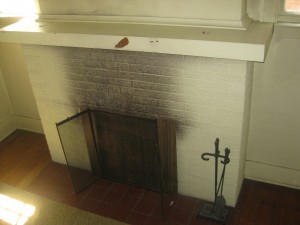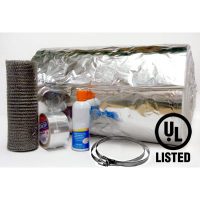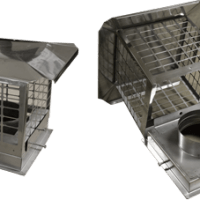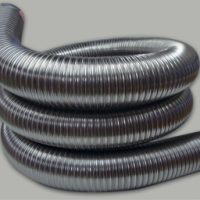I have a Smoking Fireplace
Smoke stains on the brick above a fireplace are proof of a smoking fireplace. Sometimes a little investigating work is required to discover the root of the problem. Soot stains are carbon particles. If you have soot stains, you have also had carbon monoxide fumes inside your home. Take care of this problem (which may not be caused by your fireplace) before using it again. Soot and carbon monoxide are a natural byproduct of burning wood, gas, coal and oil – any carbon based fuel.
The first thing to check is that the damper is been fully open before starting a fire!
Next, try pre-warming the flue. Keep in mind that in the winter the chimney may be filled with cold air. Since warm air rises and cool air falls, you must reverse the air flow, sending warm air up the flue. You can do this by using a bit of newspaper, tightly rolled and lit like a torch and held up through the fireplace damper. Once the smoke from your newspaper torch reverses and sends the smoke up the chimney, immediately light your fire.
Fireplace Size can cause Smoking
Large fireplaces are a stunningly beautiful feature in any room. However, proper planning and construction of a large fireplace must be considered in order for it to perform properly without causing a smoking fireplace issue.
Fireplaces must be built within a general set of guidelines for proper sizing. A fireplace with a rectangle flue should be built to an 8:1 ratio of fireplace opening to flue size. Length x width of fireplace opening provides the fireplace size length x width of flue tile provides the cross-sectional area of the chimney. Square flue tiles require a 10:1 ratio. Round flues should provide a minimal 12:1 ratio as a round flue drafts more easily.
When the fireplace chimney flue is too small to accommodate the large fireplace opening, the chimney cannot adequately remove the byproducts of combustion. It is much easier to reduce the size of the fireplace opening than to enlarge the chimney
Install a smoke guard, which is a metal bar that attaches to the fireplace opening at the top. Installing glass doors where the frame will overlap the opening on the sides, thereby reducing the opening considerably. Raise the fire by using a tall grate or tall andirons. Rebuild the firebox, which is a more expensive option. Install a fireplace insert (wood, gas, pellet, coal) with a new chimney liner sized appropriately for the stove.
Chimney Design
An exterior chimney is much colder in the winter. Before a chimney can draft properly it needs to be warmed, so an exterior chimney can present drafting problems. If you’re building a home, consider a chimney built to the interior of the home if possible. Another possibility is installing a stainless steel chimney liner with insulation. This will greatly increase your draft.
Chimney Height
The chimney needs to be at least 3′ higher than the roof where it penetrates AND 2′ taller than anything within 10′ away.
On chimneys with multiple flues, the flue tiles should be staggered in height to help prevent one flue from sucking smoke downward from the adjacent one. A chimney should be built so that its flues can be as straight as possible, bends and offsets increase resistance and reduce draft, possibly causing your smoking fireplace.
It’s preferable to have the chimney built closer to the peak of the roof than on the lower side to reduce problems. This will drastically reduce your chances of having drafting issues caused by wind. Also when the chimney is at the peak of the home, it will be higher than anything else around, providing strong draft
In our compulsive obsession to design energy-efficient “air tight” homes, we often don’t consider there must be a way for outside air to enter the house to have proper combustion. Chimneys must pull air from somewhere to provide combustion air for the fire and allow an updraft so smoke and fumes can exit, so air must be supplied at an equivalent rate to replace the air leaving the chimney. Extremely airtight homes can prevent chimneys from operating properly, especially where other air-moving devices are being used such as furnaces, bathroom or kitchen vents, attic fans, clothes dryers, radon fans, etc.
It is possible to have cold air dropping down one side of flue while warm smoke or fumes are also trying to exit at the same time. Try opening the closest window to the fireplace to provide extra air for the fireplace and make sure no fans are being used in your home at the same time.
If your chimney once worked well and now doesn’t, consider whether you may have made changes that affect its ability to draft, such as installing weather stripping, replacement windows, new siding, extra insulation, room additions, or new appliances. High efficiency clothes dryers that dry clothes more quickly can use drastically more air to operate.
There are multiple causes for a smoking fireplace. We tried to cover the most common reasons here. But if you are still having troubles with a smoking fireplace, please call us, 1-866-941-5112.







